GM Boris Gelfand (2717) -
GM Evgeny Bareev
(2675)
|
|
|
My "Game of The Month" for the period for January, 2006. (Source: TWIC # 580.)
GM E. Bareev has long been one of the world's better players. Here he defeats GM Boris Gelfand in a game to decide one of the higher places in the [FIDE] World Cup (tournament). (The opening was the primary reason that I chose this game, I have had several e-mail requests to examine this particular opening variation.) [A good book on this opening ... for the less advanced player.]
Its also a nice win by the second party.
(The large majority of my games for my GOTM column feature wins by White ... my fans e-mail me on a continual basis, one of the points that is raised quite a bit, is that you - the readers - ask for more wins by Black.) It is also an interesting GM struggle.
*** *** *** *** *** *** *** *** *** *** *** *** *** *** *** *** *** *** *** *** *** *** *** *** *** ***
{The ratings are correct and are those of FIDE. They were assigned to this game when I downloaded it from the Internet.}
1.d4 d5;
2.c4 c6; 3.Nc3,
A normal developing move.
[ GM's also play the try: 3.Nf3, as well. (Safer, possibly less sharp?) ]
3...Nf6;
Thus far, we have reached a fairly standard position from the QP opening.
(The Slav Defense.)
According to a CD-ROM on this opening, this position has been reached at the master level over 15,000 times!
[ For
3...e6!?;
4.e4!?,
see the download
for this month.
(It is a game that is thoroughly annotated in the CB format.)
]
4.e3,
(Enabling play, frees the WKB.)
White immediately does this, so as not to have to worry about Black taking his (un-guarded) Pawn on the c4-square.
[ More often seen would be moving
the
KN first, but after the continuation of:
4.Nf3 e6;
5.e3,
"+/=" we have simply transposed back to normal Slav lines ...
as in this game.
]
4...a6!?;
(Perhaps risky?) {See
the diagram - just below.}
This is in very much in vogue at the highest levels of master praxis.
One of the main ideas is to inject more possibilities for dynamic play into a seemingly dull position.
**********************************************************
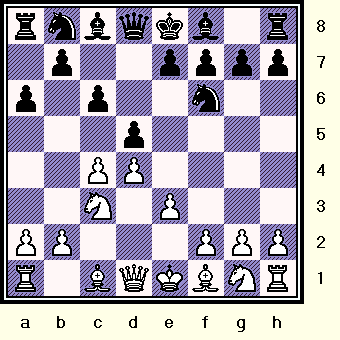 |
**********************************************************
rnbqkb1r/1p2pppp/p1p2n2/3p4/2PP4/2N1P3/PP3PPP/R1BQKBNR
w
Black also tries to save a tempo over some of the <more conventional> lines of the Slav. The second player hopes that White will play Bd3, when Black can immediately gain a tempo by (then) playing ...d5xc4. This is followed by ...b7-b5; and possibly ...c6-c5. In this way Black gets his Q-side counterplay rolling a little earlier than in the standard forms of The Slav Defense.
Of course the risks are those that are common to any player, mainly that if the game opens up and Black is caught with his King in the center, he will pay the penalty. Of course, there are other dangers to falling behind in your development ...
[ The
main line is reached after the following moves:
4...e6;
5.Nf3 Nbd7;
{Diagram?}
with an interesting and dynamic position (for both sides).
*********************************************************************************
And now play can proceed with
6.Bd3, dxc4; 7.Bxc4, b5;
8.Bd3, a6; and
Black
plays for the Pawn advance of ...c6-c5 next.
(This includes the spectrum of many variations,
as well as the main lines of
The Meran
Variation.)
[ See
MCO-14, pages # 457 through # 466,
/ and columns # 01 through column # 30. (And all corresponding notes.)
]
One famous game ... in this particular line.
*********************************************************************************
White can also play 6.Qc2, when the first player has a diversity of plans at his (or her) disposal.
[ See MCO-14, page # 468; beginning with column # 33. ]
One good game ... in this particular line. ]
5.Nf3,
White continues to develop, and there can be nothing wrong with this approach.
[ Possibly the simplest answer is for the first player to respond with:
(>/=) 5.cxd5 cxd5;
6.Nf3,
"+/=" {Diagram?}
with a slight edge, although this is seen as somewhat drawish. ]
5...b5!?;
(Really weird.)
{See the diagram given - just below.}
This line is ... "all the rage" ... (currently in fashion) at the GM level.
**********************************************************
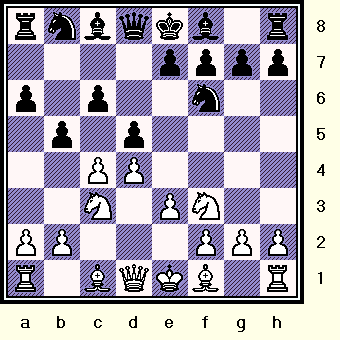 |
**********************************************************
rnbqkb1r/4pppp/p1p2n2/1p1p4/2PP4/2N1PN2/PP3PPP/R1BQKB1R w
Of course, I have lived long enough to know that fashions (in the opening) come and go at the highest levels.
What is the reason for this line being so popular? I think that they are many answers to this question. Black 'solves' the problem of his Q-side right away. (And maybe the other lines really are a shade over-analyzed.)
6.c5!?,
(Relieving the pressure?)
While popular with some players, I don't see how this can be the best. After this line-closing move, White finds it difficult to generate any meaningful play, and his button on c5 is a continual target. Further, White's Pawn structure is now very vulnerable to an advance of Black's e-pawn (to the e5-square).
[ Probably better was:
(>/=) 6.b3, ('!') 6...Bg4;
7.Be2 e6;
8.0-0 Nbd7; 9.h3!? Bh5;
10.Bb2,
"~" (Maybe - +/=")
{Diagram?}
when the position remains dynamic and both parties have good play.
See the GM contest:
Vladimir Malakhov - Alexander Grischuk; /
The Fifth (#5)
Karpov Tournament
Poikovsky, RUS; 2004.
(0-1, 60 moves.) ]
6...g6!?;
(Maybe - '!')
I like this, Black instantly focuses on the e5-square, this seems to be a much more dynamic development than to place the Bishop on e7.
[ The second player has also tried:
6...Bg4; 7.h3 Bxf3!;
8.Qxf3 Nbd7; 9.g4 e5;
10.g5 e4;
11.Qe2 Ng8;
12.h4 g6; 13.Qg4 h6!;
"~"
when the second player has good play.
GM Vadim Zvjaginsev (2654) - GM Joel Lautier (2676)
/ [D15] [replay]
/ The Fifth (#5)
Karpov Tournament
/ Poikovsky, RUS;
(R3) / 17,03,2004.
{This game was drawn after just a few more moves, without much of a real fight.}
]
Now for the next few moves, both sides simply continue to develop their pieces.
7.Ne5 Bg7;
8.Be2 0-0;
9.0-0 Be6!?N;
This move seems to be new to master-level practice, 9...Nbd7
had been played in this position ... (prior to this game).
[ Another game proceeded as follows:
9...Nfd7; 10.f4 f5;
11.Nd3 a5; 12.Bd2 Nf6;
13.Be1 Nbd7;
14.Bh4 Kh8; 15.Kh1,
"~" with unclear play. ("=")
A. Moiseenko (2663) -
Ni Hua (2603);
/ World Team Championships
Beer Sheva, ISR;
(R#6)
/ 07,11,2005. {Black won a rather strange affair ...
in 35 total moves.} ]
10.f4!?,
{See the diagram given - just
below here.}
This clamps down on the e5-square, but makes it hard for White to find a viable plan.
(The P-skeleton is now fixed, which kinda limits
White's various options from here.)
**********************************************************
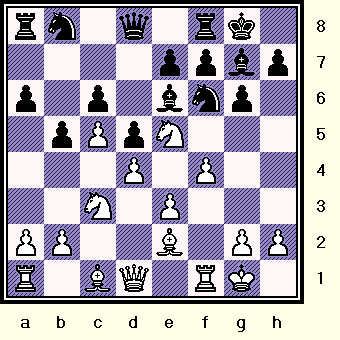 |
**********************************************************
rn1q1rk1/4ppbp/p1p1bnp1/1pPpN3/3P1P2/2N1P3/PP2B1PP/R1BQ1RK1 b
Another idea was to play f3 (with the idea of e3-e4); but I never really had the time to subject this concept to any serious analysis.
[ The box likes: 10.Bd3!?, "+/=" here. - Fritz 8.0 ]
10...Qc7; 11.g4 Ne4!; (center)
Black immediately occupies the outpost.
[ Another good plan was to play: 11...a5; "~" and try to generate some Q-side play. ]
Now Qe1 or Bd3 were both playable ideas for White, but Gelfand goes in a different direction.
12.Bf3!? f5!;
This is the right idea for Black ... for many different reasons. The two most important are to control e4 and to prevent White from
playing f4-f5, and actually making something of the <possible>
attack on the King-side.
13.Bd2 Nd7;
14.Be1!?,
This looks dangerous - and even dubious ('?!') - to me - White simply can't allow the game to be broken open here.
(The general rule of thumb is that such an opening of the game profits the player who has more development or the
better hold on the
center.)
[ Probably safer was:
(>/=)
14.Nxd7 Qxd7; 15.g5 a5;
"~"
("=/+")
when Fritz thinks that Black is just a little better, but White should be
able to hold the draw, due to the closed nature of the position.
]
14...Nxe5;
15.fxe5 Nxc3!?; {See the diagram given
... just below.}
A
very routine move - that really could be classified as a {minor}
error.
(GM E. Bareev may have missed that 15...Ng5! seems to yield a solid advantage to Black.)
**********************************************************
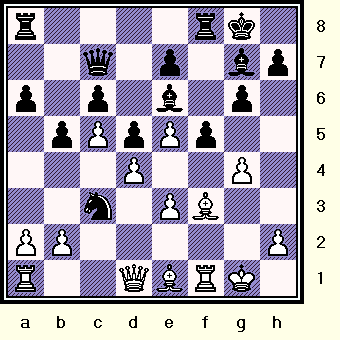 |
**********************************************************
r4rk1/2q1p1bp/p1p1b1p1/1pPpPp2/3P2P1/2n1PB2/PP5P/R2QBRK1 w
Of course it is quite possible that Bareev saw this move but did not consider it a big deal. And it is quite possible that he thought 15...Ng5; 16.Be2, is not that clear. Or ... Bareev saw both moves, and did not consider the difference between the two to be that great. Of course, the move actually chosen by Bareev (also) leads to a solid edge for Black ... and is Fritz's second move choice in the position after 15.fxe5.
[ Possibly
>/=
15...Ng5!;
"/\" (w / attack?)
was an improvement over the game.
Now
16.gxf5 Nxf3+; 17.Rxf3 Rxf5;
18.Rxf5 Bxf5; 19.Bg3 Rf8;
"=/+" ("/+")
leaves Black with an edge. (Two Bishops, a K-side initiative and the first player is
also very weak
on the light squares as well.) ]
16.Bxc3 Bh6;
17.Bd2 fxg4;
18.Bxg4 Rxf1+; 19.Kxf1 Qd7; "=/+" {See
the diagram, just below.}
Now both of Black's Bishops play an active role here.
**********************************************************
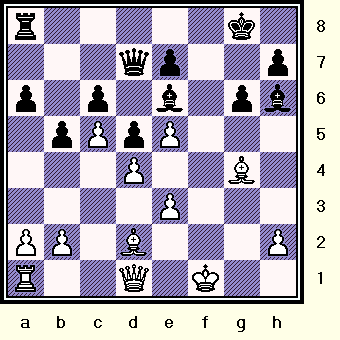 |
**********************************************************
r5k1/3qp2p/p1p1b1pb/1pPpP3/3P2B1/4P3/PP1B3P/R2Q1K2 w
Take a look at this position, ... certainly Black is a fuzz better
... ...
...
but it hardly looks like a decisive edge for either player at this point in the struggle.
** ** ** ** ** ** ** ** ** ** ** ** ** ** ** ** ** ** ** ** ** ** ** ** ** ** ** ** ** ** ** ** ** **
Now White must defend rather carefully - his King is somewhat exposed here. (Meanwhile, the second player continues to mass toward that side of the board.)
20.h3 Rf8+;
21.Kg1 Bg5;
22.Qe2 h5; 23.Bxe6+ Qxe6;
24.Qg2, (Maybe - '!')
This is probably the best defense, not only does White guard the h-Pawn, he keeps his opponent's counterpart out of the e4-square.
[ Much worse would be
</= 24.Kg2?! Qf5; 25.Rf1?
Qe4+; 26.Kh2 Rxf1; 27.Qxf1 Bxe3; "-/+"
and Black should probably win. ]
24...Bh4;
25.Rf1 Rxf1+;
26.Kxf1 Qf5+; 27.Ke2!?, hmmm
{See the diagram given - just below.}
Take a look at the current situation. White has a bad Bishop and Black has the much more active game ... and a pawn majority on the King-side, so the chances clearly favor GM E. Bareev from this position.
**********************************************************
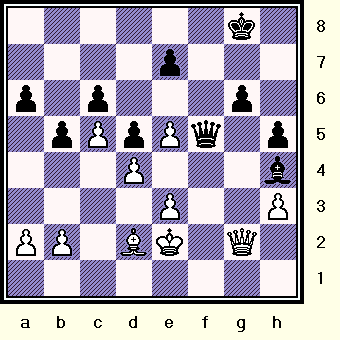 |
**********************************************************
6k1/4p3/p1p3p1/1pPpPq1p/3P3b/4P2P/PP1BK1Q1/8 b
Here an ending has been reached, and one that clearly favors Black. (The only question is: "Can Black overwhelm his opponent from this position, even with the best defense by his opponent?" I tend to think that - practically speaking - this would be a very difficult endgame to win, at least with best play by both sides.)
[ Also possible was: 27.Kg1, (but Black is still better). ]
27...Kf7;
28.e6+?, (A try at a swindle?)
UGH! I wonder what caused this error?
White is fooling himself if he thinks he has any winning chances ... even with this very wild shot! Was this caused by a battle with the chess clock? Was this game played at an accelerated time limit? Or were there other factors at work here? (Some of the games were played to break ties, possibly Gelfand was in a "must-win" situation. But in that case, his opening was completely and totally inappropriate for such an occasion!)
Was White gambling here? (This is a real possibility ... perhaps Gelfand had already given up on his game?)
[ >/= 28.b3 g5!; 29.Qf3 Kg6; "=/+" ]
Now the game can be considered a relatively simple win for Black, but both sides play on until there can be no doubt about the actual outcome.
28...Qxe6!?;
(hmmm)
This works, but my first reaction was to take with the King, and Fritz likes this try as well.
[
(>/=) 28...Kxe6; ('!')
29.Qh2 Kf6!;
30.Qb8 Kg7!;
31.Qb7!? Qxh3;
32.Qxc6 Qg2+;
33.Kd1 Qf1+;
34.Kc2 Qc4+; 35.Kd1
Qxa2; "/+"
Probably just
"-/+" (Fritz 8.0) ]
29.Qh2 Bf6;
30.Kd1 g5; 31.Qc7,
Apparently White had bet everything on this one tricky play, but it falls short of the desired result for Boris Gelfand.
The game is decided, the rest of these moves really do not require any further commentary from me.
(On move his thirty-second turn, Gelfand probably had to play his Queen to the h2-square. But that would have meant he
was
admitting that his Pawn sack on e6 was not really playable, which was apparently something he was not prepared to do.)
31...h4; ('!')
32.Kc1?!, ('?')
32...Qxh3!;
33.Qxc6?! Qh1+; 34.Kc2 h3; "-/+"
White throws in the towel, it would be a complete waste of time for him to continue (from this position).
{Black will rapidly promote his h-Pawn and make a new Queen.}
**********************************************************
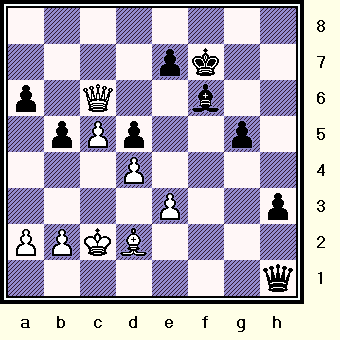 |
(The final position.)
**********************************************************
8/4pk2/p1Q2b2/1pPp2p1/3P4/4P2p/PPKB4/7q w
An excellent game by Bareev, who displays toughness in the defense, and creative ingenuity to win this complex encounter.
Copyright (c) A.J. Goldsby, 2005. Copyright (c) A.J. Goldsby, 2006.
All rights reserved.
0 - 1
|